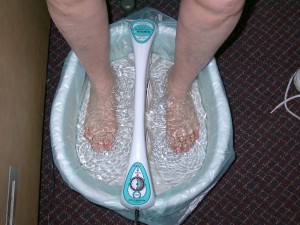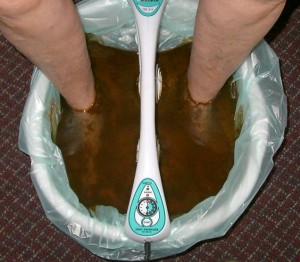I thought Dr. Fagen did a great job researching and explaining that Detox Foot baths like we use in our clinic really do “pull” bad stuff out of your body when you use them.
Dr D
Do Detoxification Foot Baths Really Work?
by Zara Fagen, PhD, ND
Ionic detoxification foot spas are the stuff of health food stores and late night infomercials. They appeal to anyone who likes the idea of improving their health easily and pleasantly.
In fact, the idea of removing impurities through our feet by simply relaxing in a 30 minute ionic foot bath sounds idyllic, and perhaps too good to be true.
After all, it has to taste bad or make you sweat in order to improve your health, right?
Well, not necessarily.
First, I can cite plenty of things that taste great (berries) and don’t make you sweat (meditation) that will improve your health, so perhaps an ionic footbath could be in that category of blissful, health improving modalities. I can already hear the birds chirping and feel the sun shining, can’t you?
The big question, however, is not whether we would like a thirty minute footbath in the name of good health, the question is whether a thirty-minute ionic footbath will improve health?
Researchers at the Canadian College of Naturopathic medicine and the University of Toronto set-out to ask that very question in their article “Objective Assessment of an Ionic Footbath (IONCLEANSE): Testing its Ability to Remove Potentially Toxic Elements from the Body.”
For me, since I have seen and heard the anecdotal evidence, the prospect of a rigorous scientific study by an objective third party was exciting. I was excited to have a scientific understanding of the usefulness or potential of this technique!
However, I am not so excited to report the results.
Instead of a definitive answer to the question, I am left with a long list of the study’s shortcomings. I can report on the little information we could possibly glean from the data presented, which is encouraging, but far from definitive.
The Basic Study Design:
The study followed six healthy people who agreed to take an ionic detoxification footbath once each week for twelve weeks.
The water before running the footbath was tested for levels of different elements, as was the water after a 30-minute footbath session without feet, and the water following a 30-minute footbath with feet.
The goal was to see whether the water contained significantly more “potentially toxic elements” after the footbath session that had feet, than a footbath session without feet.
How the Study Fell Short:
- The study included only 6 subjects.
- All of the subjects reported themselves as “healthy” and without major health complaints, yet three were taking prescription medications, and two were taking supplements (we don’t know which ones).
- My biggest complaint: The authors pooled all of the data from all six subjects, and from all twelve weeks of footbaths.That’s right, there was no information given about the individual differences in detoxification foot spa elements between subjects, or differences over the course of twelve weeks of footbaths.
By this method of pooling data, you can imagine that changes in a specific element in one subject would be diluted if the other five subjects did not release the same element into their baths. Similarly, if subjects released elements early on during the regimen, but then the detoxification subsided, those results would be diluted by pooling all of the data from all twelve weeks.
The authors also tested the levels of potentially toxic elements in urine and hair samples at specific times throughout the twelve-week trial. The urine results suggest a wide variety of individual responses, as well as individual differences in the time-course of elements appearing in the urine. For me, this supports the idea that individual differences may be significant, and that perhaps this study would have been better presented as a series of six case studies.
When the authors provided a graph of elements (again, pooled) found in post-footbath water samples over the 12-week period, there was not a reliable trend, but rather several peaks and valleys over the course of the experiment. No standard deviations were graphed. It’s hard to say which is more meaningful: the wide range of variation, or the trendline that the authors applied to the graph. I tend to think that the variation is probably more meaningful…
What We Learned:
Despite its weak experimental design, and lack of rigor in data analysis (afterall, the sample size was really too small to do anything but pool the data for statistical significance), we can learn a few interesting tidbits from this experiment.
There were statistically significant differences in the quantities of elements in the water following a footbath with feet compared to a footbath without feet.
Here are the elements that were statistically more or less prevalent following a foot bath with feet (remember, this is the data pooled from 6 subjects, 12 footbaths each):
- Arsenic levels were significantly higher when feet were in the detoxification foot spa
- Calcium levels were significantly lower when feet were in the detoxification foot spa (even lower than what was in the water before any feet were soaked)
- Chromium levels were significantly higher when feet were in the detoxification foot spa
- Cobalt levels were significantly higher when feet were in the detoxification foot spa
- Iron levels were significantly higher when feet were in the detoxification foot spa
- Magnesium levels were significantly lower when feet were in the detoxification foot spa (again, even lower than the amount of magnesium present in the water before any feet were soaked)
- Manganese levels were significantly higher when feet were in the detoxification foot spa
- Molybdenum levels were significantly higher when feet were in the detoxification foot spa
- Nickel levels were significantly higher when feet were in the detoxification foot spa
- Selenium levels were significantly higher when feet were in the detoxification foot spa
- Silicon levels were significantly higher when feet were in the detoxification foot spa
- Sodium levels were significantly lower when feet were in the detoxification foot spa (again, even lower than the amount of magnesium present in the water before any feet were soaked)
- Strontium levels were significantly lower when feet were in the detoxification foot spa (again, even lower than the amount of magnesium present in the water before any feet were soaked)
- Vanadium levels were significantly higher when feet were in the detoxification foot spa
Based on the elements that were present in different concentrations following a footbath with feet versus a footbath without feet, we can assume that certain elements are passing through the feet and into or out of the water. In this case, ten elements that were measured are presumably entering the water from the feet in statistically significant quantities. Conversely, four elements that were measured are leaving the water, presumably being absorbed by the feet.
So how do the authors conclude that “there does not appear to be any specific induction of toxic element release through the feet when running the machine according to specifications”?
The answer comes in a detail of their analysis. According to the authors, only changes in the concentration of specific elements that they have defined as “potentially toxic” will be considered “toxic element release.” The authors want us to buy into that criterion for determining the effectiveness of the footbath. Therefore, of the 14 elements that did show statistically significant changes in concentration, only arsenic falls into the “potentially toxic” category.
So, it would be possible for the authors to conclude that the IONCLEANSE may be useful in reducing levels of arsenic.
But they don’t.
Why? Well, because they pooled the data yet again! This time, the authors pooled all of the “potentially toxic” elements, and made a claim that, in total, there was no significant difference in the levels of potentially toxic elements between footbaths run with or without feet.
My critical look at the data suggests that there may be something very valuable about footbaths if we were able to take a closer look at individual differences in footbath elemental release, the time-course of release, and the correlation between elemental release and specific health complaints. Like many modalities, the benefits of footbaths may extend only to specific conditions or subpopulations.
This study did not measure the levels of other environmental toxins (parabens, for example) in the footbath water or urine samples.
In the end, it is clear that the field is still in desperate need of a rigorous scientific study that considers specific health complaints, and most importantly, has a sample size large enough to provide meaningful statistics.
Have you used a footbath or foot patch for detoxification? What are your thoughts?
Reference
Kennedy DA, K Cooley, TR Einarson, D Seely. “Objective Assessment of an Ionic Footbath (IONCLEANSE): Testing its Ability to Remove Potentially Toxic Elements from the Body.” J Environ Public Health. 2012.


